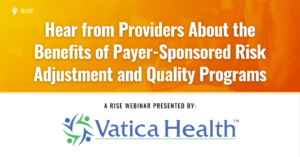When the COVID-19 pandemic first struck, small independent primary care physicians were among the first providers to feel the impact. Patients cancelled appointments out of fear or necessity. Practices shut down temporarily to comply with shelter-at-home orders. As with many businesses, some practices eventually closed their doors for good because they simply couldn’t weather the storm financially. As the pandemic raged on, even larger, system-owned practices began to feel the wrath of COVID-19. Today—nearly a year later—entire health systems both large and small are feeling the strain.
Despite these unprecedented challenges, providers have tried not to lose sight of the most important goal: to provide high-quality patient care that drives optimal health outcomes and supports the transition to value-based care.
How can they do that?
Ensure accurate and complete documentation that reflects each patient’s clinical story. Document all current and emerging chronic conditions to the highest degree of specificity. Administer all age-based or seasonal screenings and vaccines that affect health and functioning, or refer patients for these services. Encourage preventive care and behavior modification to support a healthy lifestyle.
As we look ahead, organizations must confront an ongoing shortage of primary care physicians and nurses, as well as a virus-fearful patient population that may be difficult to engage in preventive health. The ‘old way’ of addressing gaps in patient care (like during an in-person visit with a physician) probably isn’t realistic anymore. It’s time to rethink strategies and address ongoing challenges.
Following are four challenges every healthcare organization must address, along with potential solutions to ensure high-quality patient care and revenue integrity.
Challenge #1: There aren’t enough physicians working in the practice setting.
An increase in hospital admissions—including admissions for patients with COVID-19—has forced health systems in rural and urban areas to re-deploy employed physicians and their nursing staff into acute care units. With fewer providers working in the office setting comes diminished appointment availability, including appointments for preventive health. This comprehensive annual visit is a critical opportunity to identify conditions that warrant ongoing monitoring. Without this touchpoint, care gaps can easily occur. The patient’s clinical story remains largely untold, and performance in value-based care arrangements may be jeopardized.
Solution: Think outside the box.
It’s understandable that physicians are distracted by other responsibilities; however, it’s also critical that they not lose sight of reviewing patients’ chronic conditions annually. That’s where they may need help. Some have contemplated hiring a physician assistant, for example, but are hesitant to make the financial investment out of fear that patient volume won’t cover the person’s salary and benefits. The good news is that there may be other options. For example, the practice could consider participating in a health-plan sponsored program that provides clinical and administrative staff for support. Going this route prevents care gaps, reduces overhead costs, and slows the spread of COVID-19. As an added benefit, there is often a financial incentive offered for completing patient encounters.
Challenge #2: Some patients still fear coming into the office.
Even despite stringent COVID-19 protocols, many patients continue to feel that the risk of coming into the office for preventive and routine care isn’t worth it. Four out of every 10 U.S. adults say they’ve avoided medical care because of concerns related to COVID-19.
Solution: Telehealth (with patient tutorials).
Telehealth helps practices keep patients happy and safe. However, there’s one caveat: it might take a little effort to help older adults learn to use this technology. More than a third of adults over age 65 face potential difficulties seeing their doctor via telemedicine. Proactively educating patients on how to use the telehealth solution and supporting their utilization can go a long way in terms of engagement. Administrative support often includes the use of Patient Engagement Representatives to contact patients to schedule appointments, deliver appointment reminders, and educate them on telehealth tools.
Challenge #3: Patients may no longer prioritize preventive health.
During COVID-19, many patients have deferred routine and preventive care. Perhaps they lost their insurance or faced another type of financial hardship—or the physician they always saw is no longer available. Some may have even gravitated toward the idea that they don’t need a doctor because they’re able to self-diagnose using the internet. Routine and preventive health falls to the bottom of the priority list, which is especially critical for patients diagnosed with chronic conditions.
Solution: Educate patients.
Practices must be able to convey the value of preventive and routine health services. Preventive care helps physicians diagnose diseases earlier, which often results in better outcomes and lower cost of care. Routine care prevents exacerbations, reduces symptoms, and improves quality of life. Practices must be able to engage patients on a personal level while also explaining that many of these services may be covered at 100%. This education empowers patients to make the best decisions for their health.
Challenge #4: Physicians are burned out, and revenue is declining.
Forty-seven percent of family medicine physicians and 46% of internal medicine physicians say they’re burned out, and it isn’t surprising why: long and busy workdays, time pressures, and ever-increasing administrative demands. COVID-19 has exacerbated this dynamic and led to a sharp decline in patient volume that has threatened the financial viability of many PCP practices.
Solution: A comprehensive Risk Adjustment and Quality solution.
Participating in health-plan sponsored risk adjustment and quality of care initiatives can help PCPs who are struggling to close revenue and care gaps. PCPs are already overworked and dealing with the cascading effects of COVID-19. It’s critical to find a partner that provides dedicated clinical and administrative support services to reduce administrative burdens, engage patients, and improve health outcomes. The result? Increased utilization of preventive health encounters and improved financial and clinical performance in value-based care arrangements.
How Vatica Supports Health Systems
As practices continue to seek point-of-care solutions to better tell each patient’s story, they need look no further than Vatica Health. We’re accelerating the transformation to value-based care by helping providers, health plans, and patients work together to achieve better outcomes. Our team deploys on-site or virtual clinical consultants with backgrounds as RNs, LPNs, or PAs that serve as extensions of your team at no cost to the practice. Practices retain all fee-for-service payments generated from patient encounters and also receive incentives for coding visits.
The best part? It’s a health-plan sponsored initiative. That means it’s completely free for practices to participate. Learn more about how Vatica can help your practice.












